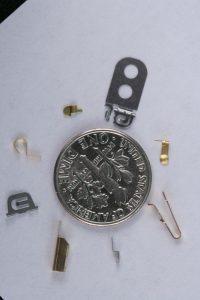 The process of precision metal stamping is cost effective, and the production rates are high. It allows you to produce larger amounts of precision parts using strip or sheet metals, typically via dedicated tooling. Many of the components created by this industry are things we use on a daily basis, including parts used in electronic devices and vehicles. Inside a smartphone, you’ll find small stamped contact pins, which allow signals and power to be transmitted through your phone. Inside your vehicle, you’ll find precision stamped parts.
The process of precision metal stamping is cost effective, and the production rates are high. It allows you to produce larger amounts of precision parts using strip or sheet metals, typically via dedicated tooling. Many of the components created by this industry are things we use on a daily basis, including parts used in electronic devices and vehicles. Inside a smartphone, you’ll find small stamped contact pins, which allow signals and power to be transmitted through your phone. Inside your vehicle, you’ll find precision stamped parts.
The process of metal stamping requires a tool with a flat face and sharp edges to be punched through a material into a mating die cavity, which is used for piercing, trimming, and blanking material. This makes it possible to create finished sheet metal parts in many shapes and sizes. It can also be used to create trimmed edges and perforations.
When a metal stamped part is being designed, it should be noted that the wall thickness will be consistent throughout the part. This may leave you wondering what happened when holes are punched in metal. What takes place when trimmed edges are created?
Punching Holes In Metal
The cutting clearances between a die and punch are specified, allowing you to predict the edge condition of a part before it is finished. One way to explain this is to say that the punch will initially compress the material. This will leave you with a top edge that’s radiused or rolled. The metal will be sheared as the sharp punch cuts through it. This will leave you with a wall that’s burnished, straight, and approximately 1/3 to 1/4 of the material thickness. Forces will eventually escalate beyond the metal’s strength. This will cause it to break away at an angle that’s equivalent to the clearance for the punch and die cutting, which will give you a burr along the material’s bottom edge.
Burrs
Burrs are a standard metal stamping byproduct. They are comparable to the flash you might see on castings or the lines you can find in plastics. Typically, blanking burrs are sharp and may be ragged. The height can vary, especially because die and punch edges tend to dull over time. With that said, you can usually expect around 10% of material thickness. It’s possible to dull burrs when necessary or to use secondary operations or mass finishing processes to remove them.
Hole Tolerancing and Dimensioning
Because the clearances for punches and dies will generally be between 8 to 10% of material thickness on each side, the bottom section of a trim or hole will be tapered to allow for this. It’s normal to measure interior dimensions at the smallest portion. There are non-standard methods that can be used if the application does not allow breakaway. In most cases, it’s possible to consistently achieve close tolerances, repeating blanking and piercing operations as needed.
It’s possible to produce large volumes of precision components when working with custom-created tooling and press equipment of the right size. It’s usually easy and affordable to adapt to tooling changes when a product undergoes revisions and improvements.





